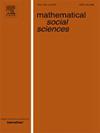Competitive attractiveness measurement in sports leagues: Sequential procedures for heterogeneous competitors
IF 0.5
4区 经济学
Q4 ECONOMICS
引用次数: 0
Abstract
The paper proposes three dominance criteria that assess whether one seasonal outcome of a sports league is more attractive than another, taking into account their respective competitive balance levels. Seasonal outcomes are distributions of seasonal points involving heterogeneous competitors (having varying sizes of fan bases). The proposed criteria are the first-degree sequential downward (FSD), second-degree sequential upward (SSU), and third-degree sequential downward (TSD) dominance criteria. The FSD criterion is axiomatically characterized in line with two principles, which require that a famous competitor (with a large fan base) matters more for attractiveness than a common competitor (with a small fan base). The SSU criterion relies on the same principles that characterize the FSD criterion and on two additional ones. First, attractiveness should increase with respect to competitive balance. Second, balance among famous competitors is more important than balance among common competitors. The TSD criterion relies on all the aforementioned principles and incorporates upside sensitivity, emphasizing that a balanced race among many famous competitors enhances attractiveness. An illustrative application provides comparisons of seasonal outcomes of the English Premier League from 2014–2015 to 2018–2019.
体育联盟的竞争吸引力测量:异质竞争者的顺序程序
本文提出了三项优势标准,在考虑到各自竞争平衡水平的情况下,评估体育联赛的一种季节性结果是否比另一种更有吸引力。赛季结果是涉及异质竞争者(拥有不同规模的球迷群体)的赛季积分分布。所提出的标准是一级顺序向下标准(FSD)、二级顺序向上标准(SSU)和三级顺序向下标准(TSD)。FSD 标准的公理特征符合两个原则,即知名竞争者(拥有大量粉丝)比普通竞争者(拥有少量粉丝)更具吸引力。SSU 标准所依据的原则与 FSD 标准相同,另外还有两条。首先,吸引力应随竞争平衡而增加。其次,知名竞争者之间的平衡比普通竞争者之间的平衡更重要。TSD 标准依赖于上述所有原则,并结合了上行敏感性,强调众多知名竞争者之间的均衡竞争会增强吸引力。一个示例应用提供了 2014-2015 年至 2018-2019 年英格兰足球超级联赛的季节性结果比较。
本文章由计算机程序翻译,如有差异,请以英文原文为准。
求助全文
约1分钟内获得全文
求助全文
来源期刊

Mathematical Social Sciences
数学-数学跨学科应用
CiteScore
1.30
自引率
0.00%
发文量
55
审稿时长
59 days
期刊介绍:
The international, interdisciplinary journal Mathematical Social Sciences publishes original research articles, survey papers, short notes and book reviews. The journal emphasizes the unity of mathematical modelling in economics, psychology, political sciences, sociology and other social sciences.
Topics of particular interest include the fundamental aspects of choice, information, and preferences (decision science) and of interaction (game theory and economic theory), the measurement of utility, welfare and inequality, the formal theories of justice and implementation, voting rules, cooperative games, fair division, cost allocation, bargaining, matching, social networks, and evolutionary and other dynamics models.
Papers published by the journal are mathematically rigorous but no bounds, from above or from below, limits their technical level. All mathematical techniques may be used. The articles should be self-contained and readable by social scientists trained in mathematics.
 求助内容:
求助内容: 应助结果提醒方式:
应助结果提醒方式:


